CEX vs DEX Geographic Access Checker
Enter your country and preference, then click "Check Access Options" to see how CEX and DEX platforms might restrict or allow your access.
Centralized Exchange (CEX)
Requires local licenses and regulatory compliance.
- Enforces KYC/AML checks
- Uses IP and ID-based blocking
- Provides fiat on-ramps
- Offers custodial security
Decentralized Exchange (DEX)
Operates on smart contracts without intermediaries.
- No KYC required
- Borderless access
- No fiat integration
- User holds private keys
When you hear about crypto trading limits that depend on where you live, the split between CEX vs DEX is the first thing to examine. Centralized exchanges (CEX) and decentralized exchanges (DEX) sit on opposite ends of the regulatory spectrum, and that difference defines who can trade, what they have to prove, and whether fiat money can be used. The following guide walks you through the real‑world geographic constraints of each model, the compliance mechanisms behind them, and what the future might look like for traders worldwide.
Key Takeaways
- CEXs must obey local licensing rules, so many countries are blocked or have limited product access.
- DEXs operate on smart contracts, allowing anyone with a wallet to trade, but emerging regulations are starting to target them.
- KYC is mandatory on most CEXs, while DEXs typically skip identity checks unless a Layer‑2 solution adds location filters.
- Fiat on‑ramps are native to CEXs and heavily jurisdiction‑dependent; DEXs rely on users to bring crypto in beforehand.
- Security responsibilities differ: CEXs guard assets centrally; DEX users must secure private keys themselves.
What Exactly Is a Centralized Exchange (CEX)?
Centralized Exchange (CEX) is a platform that holds user funds, matches buy and sell orders, and enforces regulatory compliance such as KYC/AML checks. Because a single entity controls the order book and custody, it can obtain banking licenses, integrate fiat on‑ramps, and enforce geographic blocks based on IP addresses or passport data.
What Exactly Is a Decentralized Exchange (DEX)?
Decentralized Exchange (DEX) is a set of smart contracts that enable peer‑to‑peer token swaps without a custodial intermediary. Users connect a crypto wallet, interact with the contract, and trade against liquidity pools governed by the Automated Market Maker (AMM) model.
Geographic Restrictions on Centralized Exchanges
Since a CEX must hold a license in each jurisdiction where it offers services, it creates a patchwork of availability. Typical restrictions include:
- Country bans: Nations like the United States, Japan, and Singapore require rigorous licensing; exchanges without a local license cannot accept residents.
- Product limits: Derivatives or leveraged tokens may be forbidden in Europe while allowed elsewhere.
- Fiat on‑ramp caps: Bank partnerships dictate which fiat currencies can be deposited or withdrawn, often excluding emerging markets.
These blocks are enforced automatically through KYC data (passport, national ID) and IP geo‑location services. If the system flags a user from a restricted region, the account is either disabled or limited to crypto‑only features.
Geographic Accessibility on Decentralized Exchanges
DEXs, by design, sidestep most traditional licensing. The only entry requirement is a compatible wallet, which means:
- No KYC forms, no passport scans.
- All Ethereum‑compatible chains and Layer‑2 solutions can be accessed from any country with internet access.
- Trading pairs are available as long as a liquidity pool exists, regardless of the user’s location.
However, the regulatory tide is changing. Some Layer‑2 networks are experimenting with geographic restriction modules that can filter transactions based on on‑chain IP or oracle‑provided location data.
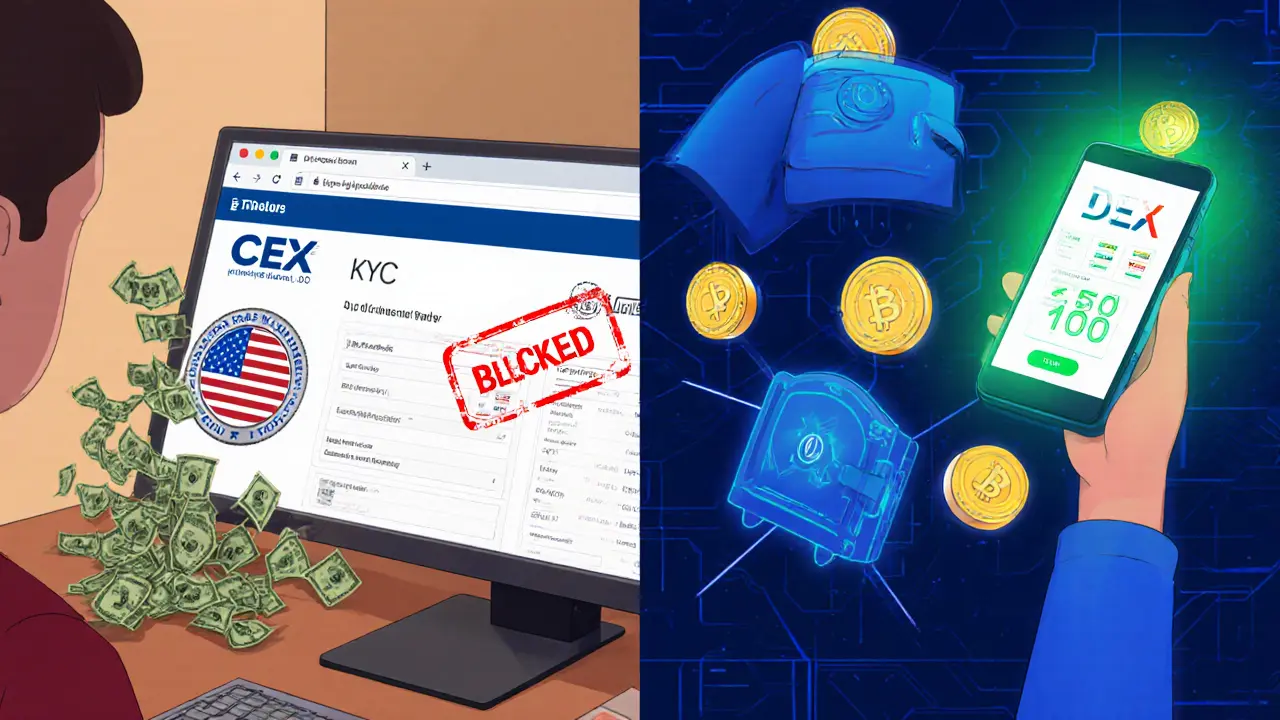
Regulatory Compliance: CEX vs DEX
CEXs operate under Know Your Customer (KYC) regulations, filing reports with anti‑money‑laundering (AML) authorities in each jurisdiction.
DEXs sit in a regulatory gray area. Since there is no legal entity to subpoena, regulators currently target ancillary services such as fiat on‑ramps, bridge providers, or token issuers that interact with the DEX. Emerging guidance from the EU’s MiCA framework and the U.S. Treasury suggests future obligations could include “location‑based filtering” for high‑value swaps.
Trading Mechanics and How They Influence Restrictions
CEXs use an order‑book model where the exchange controls who can place orders. This central control makes it straightforward to reject a user from a barred country before the order reaches the market.
DEXs rely on AMM protocols. A trade is a function call to a smart contract; the contract does not know the trader’s identity. Adding a geographic block would require an extra on‑chain check, which increases gas costs and can undermine the trust‑less nature of the platform.
Fiat Integration: A Major Point of Divergence
Most major CEXs (e.g., Binance, Coinbase) provide built‑in fiat on‑ramps, allowing users to buy crypto with bank transfers or cards. These services are tied to local banking regulations, meaning:
- Users in the United Arab Emirates can deposit AED on Binance US, but a user in Iran cannot.
- Stablecoin purchases often require proof of residence.
DEXs rarely support fiat directly. Users must acquire crypto elsewhere-often via a CEX or peer‑to‑peer service-before they can trade on a DEX. This extra step can actually help users bypass fiat‑related geographic blocks, provided they can obtain the initial crypto.
Security, Custody, and Legal Risks
On a CEX, the platform holds your private keys, offers multi‑sig cold storage, and monitors withdrawals for suspicious activity. The downside is that the exchange can be compelled to freeze or seize assets based on a court order in the jurisdiction where it is licensed.
On a DEX, you own the private key. This gives you full control but also full responsibility. If local law forbids crypto trading, you could face penalties for holding or swapping tokens, even though the protocol itself does not enforce any block.
Future Outlook: Will DEXs Remain Borderless?
Regulators are increasingly looking at “de‑risking” DeFi. Possible scenarios include:
- Soft enforcement: Exchanges that integrate with DEXs may add optional KYC layers for large trades.
- Hard forks: Some DEX projects could split to create a compliant version that respects geographic filters.
- Layer‑2 solutions: New roll‑up chains might embed location checks into the consensus layer, effectively turning a borderless DEX into a jurisdiction‑aware platform.
For traders, the practical advice is simple: if you need fiat entry or want regulatory protection, stick with a reputable CEX that operates in your country. If you value privacy and can source crypto elsewhere, a DEX offers the most unrestricted access-at least for now.
Quick Comparison Table
| Aspect | Centralized Exchange (CEX) | Decentralized Exchange (DEX) |
|---|---|---|
| Regulatory License | Required in each operating jurisdiction | None (smart‑contract based) |
| KYC/AML | Mandatory for most services | Usually absent; optional on Layer‑2 |
| Geographic Blocking | IP & ID based; country‑level bans common | Technically difficult; emerging oracle filters |
| Fiat On‑Ramp | Integrated, but limited to licensed regions | Not native; requires prior crypto acquisition |
| Custody Model | Exchange holds private keys | User holds private keys |
| Compliance Risk | Subject to court orders, asset freezes | Legal risk lies with user; protocol immune |
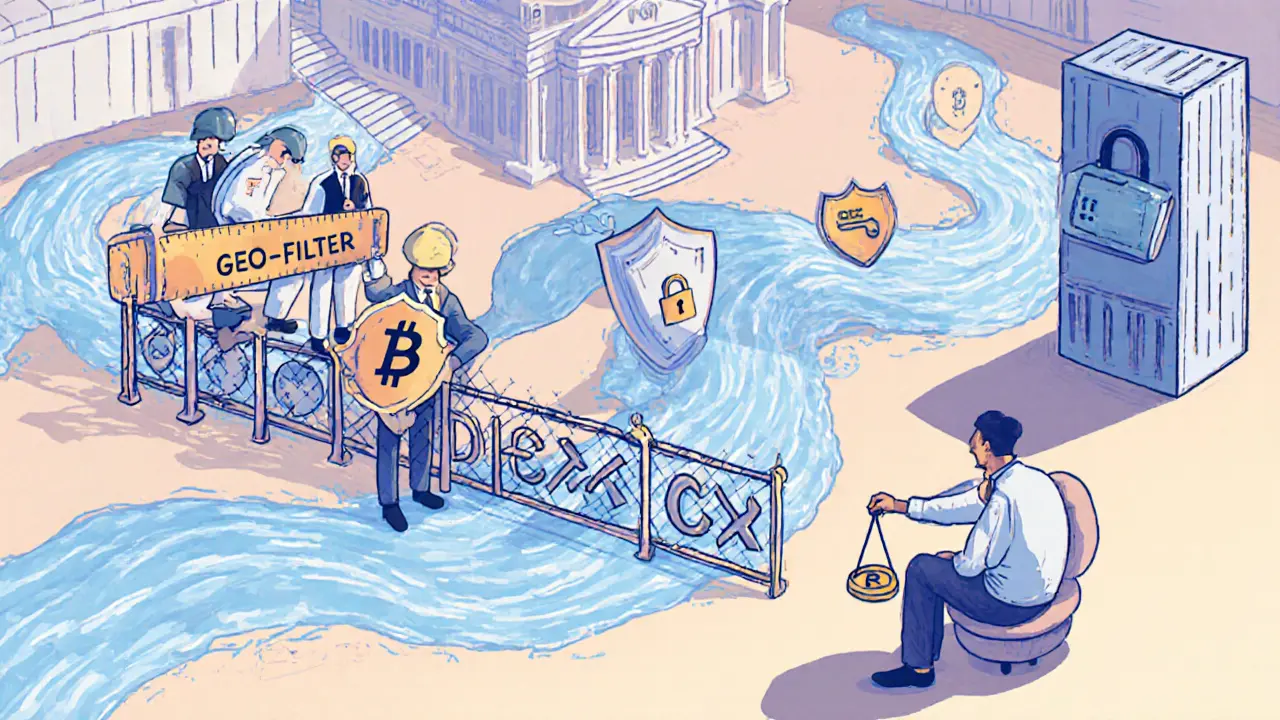
Frequently Asked Questions
Can I use a CEX if I live in a country with strict crypto bans?
Usually not. Most CEXs will block account creation or limit services for residents of countries that do not allow crypto trading, such as Iran or North Korea. You would need to look for a platform that holds a local license or use a peer‑to‑peer method.
Do DEXs ever ask for my identity?
In their pure form, DEXs do not require KYC. However, some Layer‑2 bridges or onboarding services (e.g., fiat‑to‑crypto gateways) might request ID before letting you move funds onto the DEX.
Is it safer to keep my crypto on a CEX or a DEX?
Safety depends on your skill set. CEXs provide insurance, hot‑wallet monitoring, and account recovery, but they can be hacked or seized. DEXs give you full control, but losing your private key means losing everything. Choose based on your security expertise and need for regulatory protection.
Will future regulations force DEXs to implement geo‑filters?
Regulators are drafting proposals that could require Layer‑2 protocols to embed location checks for high‑value swaps. Implementation is still early, but expect some DEX‑related services to add optional KYC layers to stay compliant.
How can I trade crypto on a DEX if I only have fiat?
You’ll need to convert fiat to crypto first-through a CEX that accepts your country’s fiat, a peer‑to‑peer service, or a regulated crypto broker. Once you own crypto in your wallet, you can connect to any DEX and start swapping.






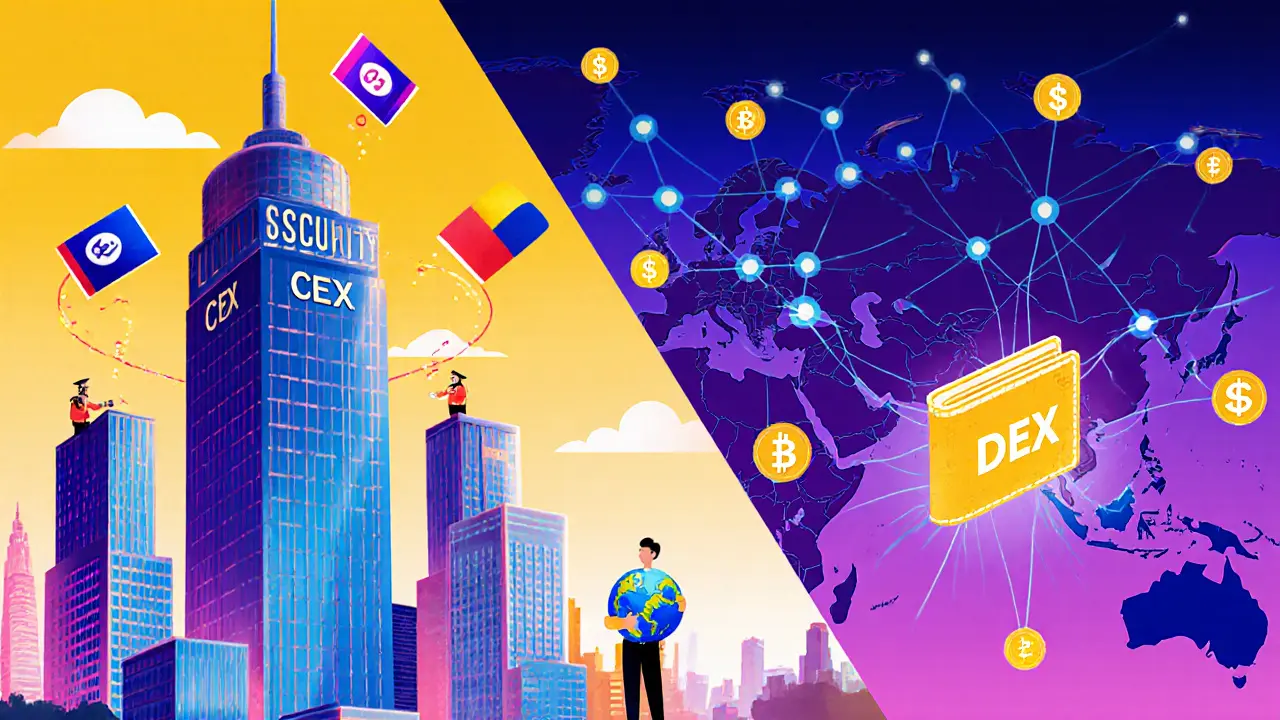


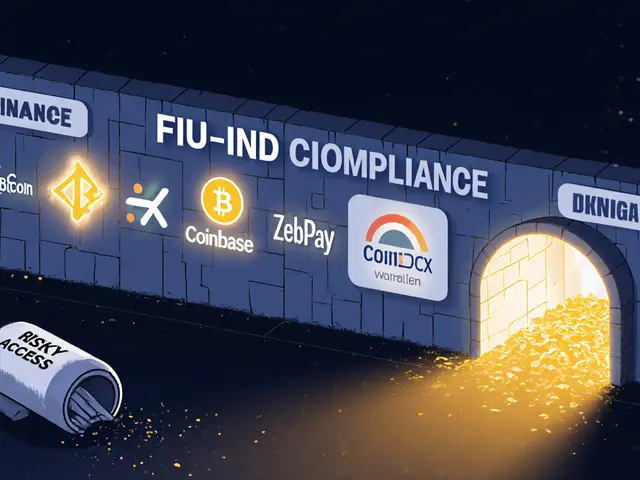
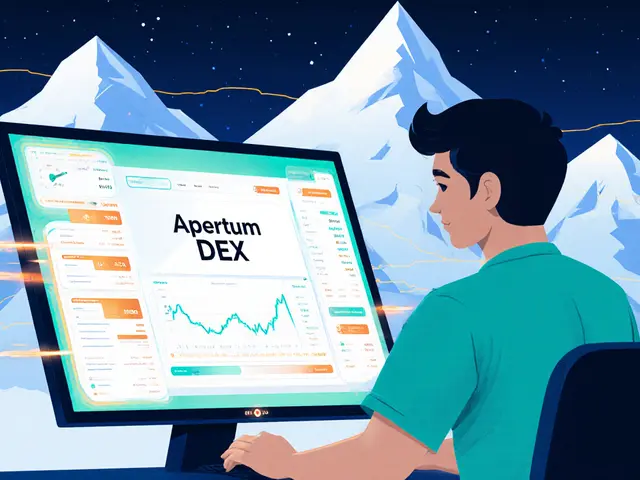

People Comments
The bifurcation between centralized exchanges (CEX) and decentralized exchanges (DEX) constitutes a fundamental vector in the regulatory topology of the crypto ecosystem.
From a compliance engineering perspective, CEXs operate as licensed intermediaries subject to jurisdictional KYC/AML schemas.
Consequently, the risk vector for IP-based geo‑filtering is instantiated at the ingress gateway, leveraging geo‑IP databases and ID verification services.
DEX protocols, conversely, are instantiated as immutable smart contracts on a permissionless ledger, thereby abstracting the notion of physical locality.
The cryptographic provenance of a transaction on a DEX is validated solely by consensus mechanisms, obviating the need for extrinsic identity attestations.
However, the emergent regulatory frameworks, such as the EU’s MiCA and the U.S. Treasury’s proposed “Location‑Based Filtering” amendment, aim to retroactively impose jurisdictional constraints on on‑chain activity.
This creates a potential attack surface whereby oracles could inject geolocation predicates into the execution path of a DEX aggregator.
From an operational risk stance, CEXs must maintain segregated custody solutions, often employing multi‑sig hardware security modules (HSMs) and insurance underwriters.
DEX participants, by contrast, shoulder custodial responsibility, which amplifies exposure to phishing, seed‑phrase compromise, and smart‑contract vulnerabilities.
The liquidity provisioning model on DEXs, driven by automated market makers (AMMs), is agnostic to user geography, yet suffers from impermanent loss and slippage under volatile market conditions.
Centralized platforms can mitigate these inefficiencies via order‑book depth and market‑making algorithms, but at the cost of centralized points of failure.
In jurisdictions with stringent fiat‑on‑ramp prohibitions, users often resort to peer‑to‑peer fiat‑crypto swaps to bootstrap DEX participation.
This bootstrapping introduces an additional compliance layer, as the intermediary fiat gateways may themselves be subject to national licensing regimes.
Moreover, the legal doctrine of “constructive knowledge” may be invoked against users who knowingly transact in prohibited jurisdictions, irrespective of the decentralized nature of the protocol.
In summary, the geographical access matrix for crypto trading is a convolution of licensing, technological architecture, and evolving statutory mandates, necessitating a nuanced strategy for global market participants.
Great breakdown! 🎉 Keep digging into the nuances, and you'll master the CEX/DEX landscape. Remember, the best strategy blends the security of CEXs with the freedom of DEXs. 🚀
Imagine a world where every trade feels like a theatrical performance-lightning‑fast swaps, dramatic price swings, and the sweet smell of gas fees in the air! 🤩 But beneath the drama lies solid advice: always double‑check contract addresses, use reputable wallets, and keep a backup of your seed phrase. The decentralized realm rewards bravery, yet punishes carelessness. So arm yourself with knowledge, and let the trades unfold like a well‑directed play. 🎭
Whoa, that's a lot of jargon, but I love it! As an American trader, I see the same regulatory hurdles every day-KYC forms, IP blocks, and the constant fear of a freeze. The CEX side feels like a bureaucratic maze, while DEXs give us the wild west vibe we crave. Still, we gotta watch out for those smart‑contract bugs. Props for the deep dive!
This piece completely glosses over the real issue: most users are clueless about the legal repercussions. If you're trading from a sanctioned country, you’re basically painting a target on your back. The author acts like it’s optional to consider AML enforcement, which is laughably naive. Stop sugar‑coating the risk and read the fine print.
Hey folks, great discussion! I think the hybrid approach works best-start on a regulated CEX to get fiat in, then move to a DEX for the freedom. Just remember to keep your private keys safe and stay updated on local regulations. Together we can navigate these hurdles! 🌟
Interesting! I've always wondered how many DEXs actually integrate location‑oracle services. Do any of them openly disclose using such filters, or is it all under the radar? Also, how does this affect gas costs when extra checks are added? Curious to hear about real‑world implementations.
Nice summary, really helped me get what’s up with CEX vs DEX. I’m more of a DEX fan cause I hate those KYC hoops.
Wow, this guide paints a vivid picture of the crypto frontier! 🌈 The CEX side feels like a polished downtown mall, complete with security guards and glossy floors, while the DEX side is a bustling street market full of hidden gems and daring traders. If you’re craving adventure, hop onto a DEX, but if you want that cozy coffee‑shop vibe, stick with a CEX. Either way, keep your eyes peeled for the occasional sidewalk snake!
Yo, drama is cool and all, but let's cut the fluff-most folks just want low fees and fast swaps. If you can't handle a simple UI, maybe DEXs aren't for you. Stop overcomplicating and just trade.
People act like DEXs are totally free, but they ignore the fact that you still need crypto to start, which is a barrier for many.
From a strategic standpoint, diversification across both centralized and decentralized platforms mitigates concentration risk. Regulatory developments, however, may alter the equilibrium, prompting a reallocation of assets. It is prudent to monitor jurisdictional announcements and adapt promptly. Moreover, custodial solutions should be evaluated not only for security but also for compliance flexibility. In essence, a dynamic, informed approach serves the long‑term investor best.
That's a fair point, but honestly, the real obstacle is fiat on‑ramps. Without easy ways to buy crypto, DEXs stay a niche for the technically savvy.
i think the article does a good job but could’ve used more examples from africa and south america, where people really feel the pinch.
Totally agree, the hybrid method works for most. I usually buy on Binance, then move to Uniswap for the tokens I need. Just make sure your wallet is secure, and don't forget to check gas fees on the network you pick.
Indeed, the dichotomy between CEXs and DEXs, while seemingly straightforward, actually embodies a complex interplay of regulatory oversight, technological architecture, and user autonomy; therefore, understanding this interplay, one must consider not only the immediate transactional benefits, but also the long‑term implications for asset security, market liquidity, and legal compliance.
It is evident, quite frankly, that the author has failed to acknowledge the pervasive influence of state actors; consequently, the analysis appears superficial, neglecting the intricate mechanisms of surveillance, tax evasion, and cross‑border enforcement that undeniably shape the crypto ecosystem.
Let's try to find common ground here-CEXs provide regulatory safeguards that many users need, while DEXs offer the freedom that others cherish. Both have valid roles in a healthy crypto market.
Oh great, another tutorial about how “easy” DEXs are.
One must acknowledge that the discourse surrounding decentralized finance often suffers from a lamentable paucity of intellectual rigor, wherein participants regurgitate buzzwords without grasping the underlying cryptographic principles that render such platforms both revolutionary and, admittedly, precariously unregulated.
While the previous commentary eloquently articulates the philosophical quandaries, it neglects to address the practical exigencies faced by everyday traders, notably the necessity for intuitive interfaces and reliable liquidity, which remain paramount concerns.